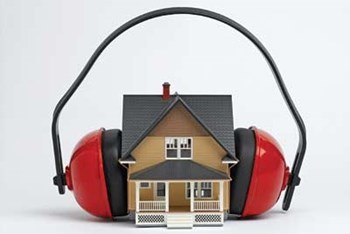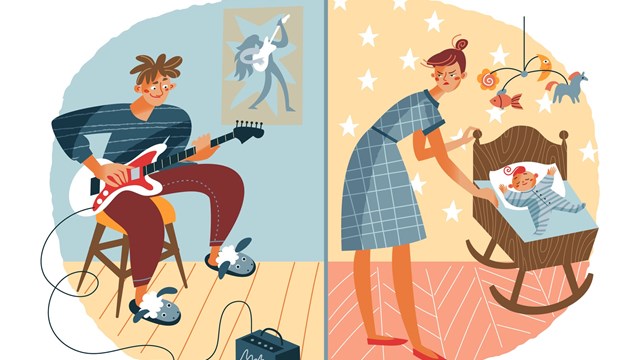
Noise is a key quality-of-life problem for almost anyone living in a densely-packed urban environment. It's the bane of many a condo-dweller’s existence, and over the years engineers, architects, and designers have tried any number of ways to reduce the problem of noise in multifamily buildings—some more successfully than others. While noise is in the ear of the beholder, there are many products and techniques on the market to help mitigate the noise associated with condo living.
When Noise Annoys
As long as people have ears and the ability to use them and live in closed quarters with others, there will be problems with noise. It’s just human nature.
Will Cronin, president of Commercial Thermal Solutions in Spring Lake, New Jersey, says that there are two variables that affect noise: people hear noise differently and different tenants create noise differently so what irritates one person may not bother another. In community living, this can make the issue of noise especially difficult because it is so subjective.
Mandy Kachur, vice president of public relations for the Institute of Noise Control Engineering/USA, says, “Sounds that are transient, that come and go, that start and stop”—like hammering a nail into a wall—“or tonal noises, like whistles, tend to be more annoying than a steady broadband of white noise”—like the hum of a washer and dryer.
What distinguishes sound from noise, however, is the ear of the beholder. “Complaints arise from the noise that someone else is making,” says Kachur. “It doesn’t matter how much noise you make.”
The culprit of residential noise however, is pretty universal across the board: most industry experts will agree that the bulk of noise complaints arises from construction issues: walls being too thin, squeaky floors and hearing neighbors talk and walk upstairs. “Most of the problems that I see are from hardwood floors,” says Cronin. “Also, when developers built the units, they didn't specify the materials that help deaden the sound transmission between units.”
There are two basic types of noise: impact noise, which would be footfalls or walking and airborne noise, such as talking, yelling, the sound of the TV or music, says Bob Orther, senior technical adviser at Soundproofing America Inc., a national company based in San Marcos, CA.
Sound, By the Numbers
There are three grades, per HUD, given buildings as it pertains to noise. Grade 1 is luxury; grade 3 is the aural equivalent of living in a cardboard box on Bloomfield Avenue; grade 2 is everything else.
STC, or sound transmission class, pertains to what’s called airborne sound—voices, music, dog barks, your neighbor’s kid practicing her violin, and so forth.
The American Society for Testing and Materials (ASTM) has developed a ratings system that assigns an STC number to building materials corresponding to how effectively it diminishes the transfer of noise. This number derives from a mathematical formula involving sound attenuation values and transmission loss curves and other technical data. A low number indicates sound flowing easily through the wall—a rating of 25, for example, means you can hear conversations as if the wall didn’t even exist. Forty is the baseline number, the minimum rating for what acoustical engineers call “privacy.” Anything above 60 and, as they say in horror movies, you’ll never hear them scream. “The luxury grade has higher acoustical ratings than average grade,” says David Ingersoll, national sales manager for Acoustical Solutions in Richmond, Virginia.
Sound quality did not become a factor in residential buildings until fairly recently. “Builders started paying attention to soundproofing in the 1970s,” Ingersoll says, when the U.S. Department of Housing and Urban Development’s Office of Policy Development and Research issued its groundbreaking, if not eardrum-shattering, Noise Assessment Guidelines.
The guidelines, according to Benjamin Bobo of HUD’s Office of Policy Development and Research, “were developed to provide HUD field staff, interested builders, developers, and local officials with an easy-to-use method of evaluating noise problems with a minimum of time and effort.” Builders cannot construct a condominium too close to Newark International Airport, for example, because of HUD restrictions on STC.
The other sound measure is IIC, or impact insulation class, which measures “impact” sounds, such as the clack-clack-clack of the stiletto heels worn by your upstairs neighbor as she walks around her ceramic-floored kitchen at 5 a.m.
“The biggest challenge now is IIC numbers,” Ingersoll says. “Years ago, it wasn’t an issue, because people used an awful lot of wall-to-wall carpeting. Now, they want hardwood floors, they want ceramic tile,” and those materials don’t naturally dampen noise. “Because there’s no longer a cushion above the floor, it must now be under it.”
The solution is to have a layer of one of many materials—recycled rubber or recycled wood are two common choices—beneath the floorboards.
Soundproofing
Soundproofing is the term most commonly used to describe the process and techniques used to mitigate sound. But as many industry pros will say, to completely soundproof a room would cost thousands of dollars and it would probably be more economical to move. The strategies used today can help reduce noise, some more successfully than others. “Your actual goal is to get the noise to a tolerable level, a level where it doesn't bother you. Because of soundproofing, you can get close to perfect soundproofing but it could cost thousands of thousands of dollars,” explains Orther.
Your first option could be double or triple-glazing the windows. “The weakest point [of sound transmission] is the windows,” says Art Barkman of the Sound Management Group, LLC in Hillsborough. “If you have a window that faces the outside and you have sound or traffic noise coming in, the way to block that is to add another layer of glass. Adding another layer of glazing will help you out quite a bit in stopping the sound from coming in the window.”
For existing walls, “the first remedy that I would recommend is dense-packed cellulose insulation,” says Cronin. It is made out of recycled wood fiber, primarily newspaper, which is treated with a fire retardant. The insulation is “blown in” into the wall structure and not only provides sound control but “also reduces the cycling of your heating and cooling units and results in reduced maintenance costs and more efficient operation of those units,” details Cronin's company website, www.commtherm.com.
A common method to deal with noise is to sound isolate the ceiling, which is an intricate but highly-effective process. “You'd have to take down your drywall ceiling. You would put up in the ceiling cavities, a rock wool, which is a mineral wool material that's made from mining slag, very dense. You'd put that up against the subfloors of the people above. You'd fill the rest of the cavity with regular insulation,” says Orther. “From there, you would put up on the base of the stud, a product called mass-loaded vinyl, and this is a vinyl material that's impregnated with barium salt and silica that give it mass,” explains Orther. The mass would be then sealed around the seams and one could either float the ceiling with sound clips or a resilient channel. Orther recommends using the sound clips to provide extra sound insulation, reducing sound by 50 to 60 percent.
Another effective product is called Green Glue which is “an adhesive that separates one layer of drywall from another and in so doing provides a cushion and prevents the mechanical linkage of one wall to another. So if you take an extra layer of sheetrock and you just add it in there, it helps, but not as much as separating them,” says Barkman. He continues to explain that just slapping another sheetrock layer on will still allow the walls to move as one with sound but separating the two layers creates a better barrier.
Orther illustrates how Green Glue works with a simple straightforward analogy. “If you have a small child and he's in a room beating on a drum, it's driving you crazy. If you walk in there and put your finger on the drum while he's beating on it what happens? It muffles it and stops that noise from resonating. That's what Green Glue does to the drywall. It damps it to where it can no longer resonate or no longer vibrate with the sound and that's what you want.” He adds that Green Glue helps mitigate high frequency as well as low frequency sounds, which are harder to combat because they are a longer sound wave.
Cork, the old standby used famously by the novelist Marcel Proust in his Paris apartment, is still effective at blocking sound—mostly impact sound. Because it is renewable, it has its apologists among green builders as an under-layer in flooring. But cork breaks down fairly quickly.
Serious Energy, a Sunnyvale, CA soundproofing and energy management company, makes a form of damped drywall called QuietRock. A technique called constrained air damping is used to dull vibrations—in effect blanketing soundwaves. “It’s like a shock absorber,” Kachur explains. These materials are specifically engineered to dull the sound in the frequencies of human speech, she says. There are two problems with soundproofing. The first is price. “It’s very expensive,” Kachur says. “If you build a five-story condo—that might be prohibitively expensive. But to soundproof the downstairs video room? That’s probably worth it.”
The second problem is—it’s an arduous job to soundproof a condo that someone lives in. The place has to be gutted, with new layers added to the floor, ceiling, and walls.
“The hardest part is, once people are in, it’s almost too late,” says Ingersoll. “They need to be built through beforehand.”
Unfortunately, because the concept of noise is so subjective, it is has been difficult to establish some type of regulations and building codes for it. “There are a lot of building codes but not many relate to noise control at all. There are many that relate to fire, primarily, as well as structural components. But in terms of noise isolation or prevention, it doesn't happen,” says Barkman.
So if you’re planning on buying a condo or an apartment, you’d better be sure and know how it sounds at Saturday night, or early in the morning. If it’s too noisy, once you move in, you’ll never hear the end of it.
Greg Olear is a freelance writer and a frequent contributor to The New Jersey Cooperator. Editorial Assistant Maggie Puniewska contributed to this article.






Leave a Comment